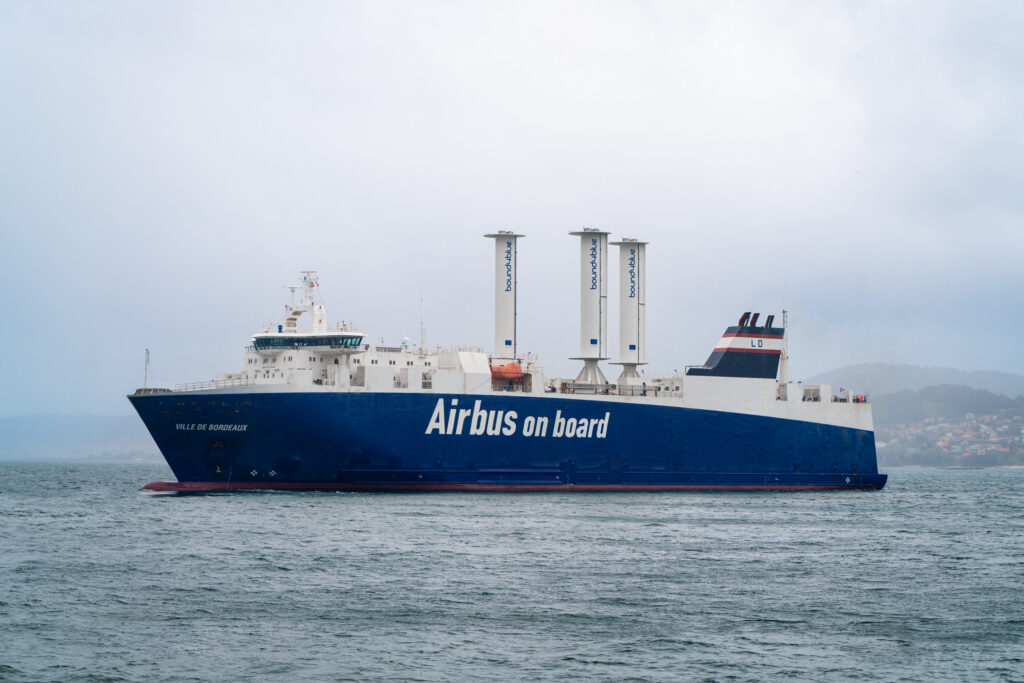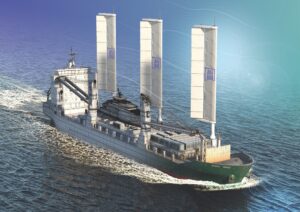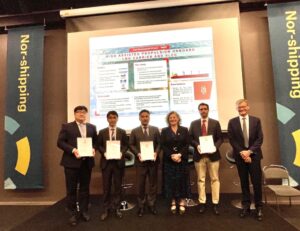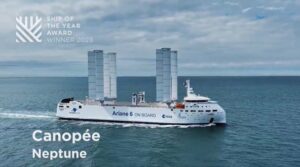Op-ed: Sailing towards sustainability
The following article is an op-ed piece authored by Aude Leblanc, Technology Leader – Sustainable Shipping at Bureau Veritas Marine & Offshore (BV), who delves into the dynamic landscape of wind propulsion for shipping and the intricate considerations surrounding its integration into vessel designs.

In an era defined by the urgency of climate change, the shipping industry finds itself at a pivotal juncture marked by excitement and promise. With the clock ticking on reducing greenhouse gas (GHG) emissions and achieving net-zero operations, the need for transformative solutions has never been more pressing. Amidst this backdrop of environmental imperative, wind propulsion emerges, offering a tangible pathway towards decarbonisation.
Years of dedication and remarkable technological advances have brought us to a moment where innovations like wind propulsion technologies (WPT), once confined to the realm of experimentation, stand ready for widespread adoption. Picture this: towering waves crashing against the hull of a cargo vessel, its sails billowing in the brisk ocean breeze. This isn’t a scene from the past but a glimpse into the future of sustainable shipping. WPT, in its essence, harnesses the power of wind to propel vessels across the world’s oceans, significantly reducing their reliance on fossil fuels and slashing emissions in the process.
As regulatory bodies such as the International Maritime Organization (IMO) and European Union (EU) enact regulations aimed at bringing the maritime sector to climate neutrality by 2050 with net-zero GHG emissions, the urgency for change is palpable. However, the current lack of clarity on regulations and technologies is causing hesitation among industry players, slowing down technology adoption.
Due to more limited resources and technical capabilities, owners of smaller fleets in particular require clarity on regulatory expectations, short-term support mechanisms, and the performance implications of new technologies. Transparent regulations and operational measures enable informed decision-making, while proven technology performance and safety reassure stakeholders of investments’ viability. Practical, proven solutions that are adapted to specific operations are crucial for smaller players to contribute effectively to shipping’s climate goals.
Here, the dynamic landscape of wind propulsion for ships stands out as a game-changer, offering not just technological innovation but a paradigm shift towards cleaner operations. It’s not merely about retrofitting sails onto ships; it’s about embracing a holistic approach to maritime sustainability. From the high seas to shipyards, from regulatory frameworks to real-world applications, wind propulsion is reshaping the maritime narrative and charting a course towards a greener tomorrow.
Constraints, challenges, and considerations
Incorporating wind propulsion systems onto ships inevitably impacts a wide range of operational aspects and involves addressing various design challenges. These include technical constraints on their integration on ships, considering stability, structural integrity, weight distribution, and manoeuvrability, as well as how the technology will interact with other systems on board. Additionally, the effectiveness of wind propulsion is limited by both the design of the vessel and its operational practices.

As a result, specific wind propulsion technologies are selected to match particular conditions and constraints, taking into account the ship’s characteristics and operating routes. This emphasises the importance of adopting a holistic approach to implementation.
Technical considerations such as stability and manoeuvrability are crucial in integrating wind propulsion systems. Ship stability must be thoroughly assessed due to induced heel by wind propulsion systems, as well as the impact of the additional weight on the ship’s load lines and tonnage. This is essential as a ship’s stability profile may limit the conditions in which the wind propulsion system can be used and varies depending on the ship’s type and unique characteristics.
For instance, tankers and bulkers generally have sufficient stability margins, but using wind can be trickier for ferries, which tend to have a smaller stability reserve. Wind propulsion can also affect rudder load and steering, influencing manoeuvrability, while maintaining visibility to comply with regulations, especially for retrofits, presents another challenge.
Moreover, there are several key areas involved in ensuring safety, including load on the hull, extreme conditions such as green water on deck, blackout, reliability of wind technology control systems, safe navigation, and visibility from the bridge. The environmental conditions in which each wind propulsion system can be safely operated are detailed in the system’s operational manual, which mainly sets limits on the wind conditions and sea state in which the system can be used.
Further to the operational conditions prescribed by the wind propulsion system itself, Bureau Veritas’ Rule Note for Wind Propulsion Systems (NR 206) provides for different configurations of the system when in operation. For instance, one of the main requirements to ensure the global safety of the system is a rule on “extreme conditions”, when winds are too strong and wind propulsion systems cannot be used.
-

Posted: over 3 years ago
To comply with regulations, another requirement BV outlines is to ensure that any structure placed in front of the ship doesn’t restrict visibility. Visibility from the bridge is extremely important, as this will govern the location and number of wind propulsion systems able to be installed onboard the ship. This is generally easier to achieve for newbuilds, which offer the option of installing the bridge at the front of the ship.
For retrofitted wind propulsion systems, determining the number of systems that can be installed on the ship whilst meeting visibility and stability requirements is essential. Optimal locations should be considered to maximise deck space and ensure the best performance. Integrating the system’s foundations with the ship’s hull may require structural modifications to reinforce the hull, including changes to the ship’s anchor and chains, stabilising elements, and steering and manoeuvrability equipment.
These challenges underscore the complexity of integrating wind propulsion systems into new vessel designs, especially amid the growing demand for WPT solutions and the industry’s decarbonisation ambitions. Addressing these challenges will be crucial for the safe, reliable, and compliant adoption of wind propulsion technologies as more owners turn to wind technology.
Supporting safe innovation
Regulatory bodies, such as the IMO, have not yet established industry-wide regulations for wind propulsion systems. Consequently, wind propulsion systems remain unincorporated into relevant existing legislation for commercial vessels.
Currently, compliance is evaluated on a case-by-case basis, with classification rules playing a pivotal role in ensuring safety and standardisation.
BV’s Rule Note NR 206 serves as the primary classification framework for wind propulsion, addressing safety risks, ship impact, as well as interactions with other onboard systems and the management of operations in a variety of environments and sea conditions. This comprehensive set of rules provides load cases, coefficients, and safety measures covering the different types of wind propulsion technologies such as modern and traditional rigs, free-standing and rotating rigs, and less mature technologies such as kite wings, rotor sails, and suction wings.
The Rule Note contains requirements for the design of the safety and operating components of the structure, the drive system, base ship; construction and testing; certification of materials and components; and classification of ships fitted with such wind propulsion systems. Also included in the NR 206 are comprehensive requirements for risk analysis and hazard identification (HAZID) studies, automation and release systems, and ship strength and safety. Elements as varied as the quality of the materials, lightning protection and the choice of anchor are also covered.
BV’s rules detail two main load cases: operational conditions and extreme conditions. Operational conditions are defined by the manufacturer’s specifications regarding sea state, wind speed, and configurations. As a classification society, BV’s role is to validate that the conditions set by the manufacturer leave sufficient safety and stability margins, in line with BV’s Rules. In extreme conditions, such as winds over 70 knots, BV mandates specific secure configurations to mitigate risks. For example, in adverse weather or sea conditions, the wind propulsion system cannot be in operation and all sails must be folded and all systems immobilised.
As of January 2024, Bureau Veritas updated the NR 206 to clarify stability requirements and reflect the latest developments, including criteria for composite materials. These efforts ensure the safety of wind propulsion systems and reflect the classification society’s commitment to evolving with the industry by providing a framework for safe innovation crucial for developers and shipowners alike.
The groundwork laid in previous years has set the stage for substantial progress, with wind propulsion systems transitioning from experimental to widely adopted solutions.
This is underpinned by BV’s robust classification rules guiding their integration, ensuring comprehensive evaluation of stability, structural integration, and weight compatibility.
Wind propulsion systems in practice
The application of wind propulsion solutions in the maritime industry represents a significant stride towards meeting emissions regulations and advancing sustainable shipping practices.
Bureau Veritas plays a pivotal role in fostering collaborations and facilitating the adoption of wind propulsion technologies among shipowners. An example of this can be seen with BV’s collaboration with Hyundai Heavy Industries (HHI), TotalEnergies Gas & Power, and Mitsui O.S.K. Lines (MOL) on a joint project to explore wind-assisted propulsion for Very Large Crude Carriers (VLCCs) and LNG carriers.
-

Posted: 9 months ago
This project, which focused on wing sails and a rotor sail system, received an Approval in Principle (AiP), confirming the compatibility of these technologies with existing classification rules and regulations for such vessels.
This milestone paved the way for more detailed work to address specific risks, enabling the progression of detailed design and arrangement plans. The Canopée cargo ship, equipped with four automated articulated vertical wing sails, represents a landmark example of wind propulsion technology implementation and was the first time that BV’s NR 206 Rules were applied to a real-life newbuild vessel.
The 121-meter ship, jointly chartered by Zéphyr et Borée and Jifmar Offshore Services, stands as a pioneering example of 21st-century merchant ships embracing wind propulsion technology. Each wing sail spans 363m2 and is supported by a 30-meter mast.
Bureau Veritas provided support to the owner and shipyard throughout the process, validating key aspects including stability, structural integrity, and weight. BV’s meticulous validation process ensured the successful implementation of the wind propulsion system, demonstrating the importance of adopting a holistic approach when installing wind propulsion.
-

Posted: 4 months ago
The retrofitting of existing vessels with wind propulsion systems presents both challenges and opportunities in the pursuit of sustainable shipping. A prime example is BV’s involvement in retrofit projects like the installation of Bound4Blue suction sails on the ro-ro vessel Ville de Bordeaux, owned by French shipowner Louis Dreyfus Armateurs, highlighting the need for comprehensive validation encompassing structural modifications, stability assessments, and energy balance considerations.
This project included validating structural deck reinforcement, anchoring, and mooring equipment, as well as ensuring that the electrical balance of the vessel meets the demands of the system’s automation, and the suction sails themselves. Through collaboration with shipowners and meticulous oversight of retrofit modifications, BV facilitates the seamless integration of wind propulsion solutions into diverse vessel fleets.
In addition to working directly with a number of developers of wind propulsion technologies, BV participates in partnerships to share knowledge and best practices. These include the Joint Industry Project WiSP (Wind-Assisted Ship Propulsion) which focuses on reviewing the regulatory landscape to recommend improvements and clarifications, as well as the development of a basic performance prediction tool to provide ship owners and operators with fast low-cost predictions for their fleets.
Outlook
Classification societies, such as Bureau Veritas, not only validate the safety and compliance of new wind propulsion systems but also offer guidance crucial for the technology’s development, while giving shipowners confidence in these solutions.
Looking ahead, BV remains committed to supporting sea trials which are essential to validate performance and safety, as well as fostering cross-industry collaborations to build knowledge and advance standardisation for wind propulsion technologies, reflecting a proactive approach towards safe innovation.
Developing knowledge is essential for assisting shipowners in choosing suitable technologies for their fleets and operations, while considering both design and operational factors.
The ongoing update of the IMO’s regulatory framework is considered crucial for the inclusion of wind propulsion, highlighting the need for continuous adaptation to technological advancements. Initiatives like the NORVENT project, aimed at harmonising performance assessment methodologies to deliver shared reliable guidelines, is a great example of this. The project is also working to deliver online training in wind propulsion for seafarers and is led by the International Windship Association’s (IWSA) Europe-Atlantic hub.
As a member of the International Association of Classification Societies (IACS), BV is actively engaged in formulating standards to integrate wind propulsion into the relevant regulations. This endeavour is pivotal in bolstering the confidence of shipyards and shipowners to embrace wind power as they navigate the path towards decarbonisation.
The maritime industry’s journey towards decarbonisation is multifaceted, with each sector facing unique challenges and opportunities influenced by operational patterns and stakeholder pressures. Despite complexities, there is a consensus that pragmatic, yet ambitious decarbonisation strategies are essential for all players, regardless of their size.
In this context, wind propulsion technology emerges as a promising solution to decarbonise shipping, offering a renewable energy source independent of energy market concerns. The growing recognition of wind propulsion’s benefits is expected to drive increased adoption across the maritime sector in the coming years.
In early 2023, there were 23 large commercial vessels equipped with wind propulsion systems, representing more than one million deadweight tons (dwt) of cargo-carrying capacity. Now, the number of ships with wind propulsion systems has increased to 37, with ten more wind-ready vessels, totalling over two million dwt of shipping cargo capacity.
In addition, according to IWSA, up to 16 ships are pending wind propulsion system installations in the coming months. By 2050, it is estimated that roughly 30,000 merchant ships will be using wind propulsion.
This shift underscores the industry’s commitment to embracing cleaner and more sustainable solutions, marking a significant step towards a greener maritime future. As technological advancements continue to accelerate, collaboration and knowledge-sharing will be vital in navigating these transitions effectively.
- Wind-assisted, LNG-electric containership Trade Wings 2,500 wins BV’s AiP
- German shipowner picks Norsepower’s rotor sail to fit on cement carrier
- BV okays Solid Sail system to help cut large cruise ship emissions
- Opinion: Can wind propulsion weather the approaching perfect storm?

